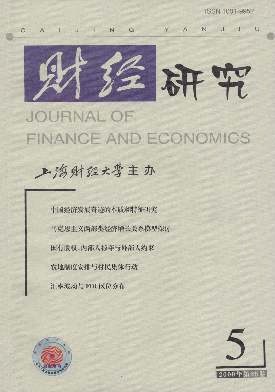FDI视角:跨国厂商技术研发量的经济模型分析
财经研究 2009 年 第 35 卷第 05 期, 页码:133 - 144
摘要
参考文献
摘要
文章通过构建一个"研发—生产"两阶段博弈模型,在FDI背景下分别以Cournot竞争模式、Stackelberg竞争模式和Collusion竞争模式研究了东道国市场规模、东道国厂商工资水平以及东道国厂商技术研发量对跨国厂商技术研发量的影响。研究发现,在三种竞争模式下,东道国市场规模对跨国厂商技术研发量都是正向的影响;在Cournot竞争模式和Stackelberg竞争模式下,东道国工资水平对跨国厂商技术研发量也是正向的影响,而在Collusion竞争模式下,东道国工资水平对跨国厂商技术研发量的影响则视产量效果与替代效果的相对大小而定;在Cournot竞争模式和Stackelberg竞争模式下,东道国厂商技术研发量的增加反向影响跨国厂商技术研发量,而在Collusion竞争模式下,东道国厂商技术研发量则不影响跨国厂商技术研发量。
[1]蔡宜臻,邱俊荣.对外直接投资于研究发展[J].经济论文,2007,35(1):53-82.
[2]谭峰,杜德斌.跨国公司在大陆的R&D投资及应对策略[J].投资研究,2003,(8):26.
[3]薛澜,沈琼红,王书贵.全球化战略下跨国公司在华研发机构投资布局[J].管理世界,2002,3:33-42.
[4]Antonio Tesoriere.Endogenous R&Dsymmetry in linear duopoly with one-way spillo-ver[J].Journal of Economic Behavior&Organization,2008,66(2):213-225.
[5]Chang-Yang Lee,Taeyoon Sung.Schumpeter’s legacy:Anewperspective on the rela-tionship between firmsize and R&D[J].Research Policy,2005,34:914-931.
[6]Chol-Won Li.Growth and scale effects:The role of knowledge spillovers[J].Econom-ics Letters,2007,74:177-185.
[7]d’Asprement C,A Jaquemin.Cooperative and noncooperative R&Din duopoly withspillovers[J].American Economic Review,1988,32:1133-1138.
[8]Eva M Mora-Valentin,Angeles Montoro-Sanchez,Luis A Guerras-Martin.Determi-ning factors in the success of R&D cooperative agreement between firms and researchorganizations[J].Research Policy,2004,33:17-40.
[9]John H Dunning.Multinational enterprise and the global economy[M].Wokingham,U.K.:Addison-Wesley Publishing Company,1993.
[10]Kamien MI,E Muller,I Zang.Researchjoint ventures and R&D cartels[J].Ameri-can Economic Review,1992,82:1293-1306.
[11]Kuemmerle.The drivers of foreign direct invest ment into R&D:An empirical investi-gation[J].Journal of International Business Studies,1999,30:11-24.
[12]Kuen-Hung Tsai,Jiann-Chyuan Wang.Does R&D performance decline with firmsize?—A re-examination in terms of elasticity[J].Research Policy,2005,34:966-976.
[13]Nagesh Kumar,Aradhna Aggarwal.Liberalization,outward orientation and in-houseR&D activity of multinational and local firms:A quantitative exploration for Indianmanufacturing[J].Research Policy,2005,34:441-460.
[14]Ove Granstrand.Internationalization of corporate R&D:A study of Japanese andSwedish corporations[J].Research Policy,1999,28:275-302.
[15]Prasade Reddy,Jon Sigurdson.Strategic location of R&D and emerging patterns ofglobalization:The case of Astra Research Centre in India[J].International Journal ofTechnology Management,1997,14,(2-4):344-361.
[16]Rosenberg N.Schumpeter and the endogeneity of technology[M].Routledge,London,2000:78.
[17]Volker Grossman.Howto promote R&D based growth?Public education expenditureon scientist and engineers versus R&Dsubsidies[EB/OL].Journal of Macroeconomics,2007,www.elsevier.com/locate/j macro.
[18]Zejan Mario C.R&D activities in affiliates of swedish multinational enterprises[J].Scandinavian Journal of Economics,1992,(3):487-500.
[19]Zhuang I,Ritchtie R,Zhang Q.Managing business risks in China[J].Long RangePlanning,1998,31,(4):606-614.
[2]谭峰,杜德斌.跨国公司在大陆的R&D投资及应对策略[J].投资研究,2003,(8):26.
[3]薛澜,沈琼红,王书贵.全球化战略下跨国公司在华研发机构投资布局[J].管理世界,2002,3:33-42.
[4]Antonio Tesoriere.Endogenous R&Dsymmetry in linear duopoly with one-way spillo-ver[J].Journal of Economic Behavior&Organization,2008,66(2):213-225.
[5]Chang-Yang Lee,Taeyoon Sung.Schumpeter’s legacy:Anewperspective on the rela-tionship between firmsize and R&D[J].Research Policy,2005,34:914-931.
[6]Chol-Won Li.Growth and scale effects:The role of knowledge spillovers[J].Econom-ics Letters,2007,74:177-185.
[7]d’Asprement C,A Jaquemin.Cooperative and noncooperative R&Din duopoly withspillovers[J].American Economic Review,1988,32:1133-1138.
[8]Eva M Mora-Valentin,Angeles Montoro-Sanchez,Luis A Guerras-Martin.Determi-ning factors in the success of R&D cooperative agreement between firms and researchorganizations[J].Research Policy,2004,33:17-40.
[9]John H Dunning.Multinational enterprise and the global economy[M].Wokingham,U.K.:Addison-Wesley Publishing Company,1993.
[10]Kamien MI,E Muller,I Zang.Researchjoint ventures and R&D cartels[J].Ameri-can Economic Review,1992,82:1293-1306.
[11]Kuemmerle.The drivers of foreign direct invest ment into R&D:An empirical investi-gation[J].Journal of International Business Studies,1999,30:11-24.
[12]Kuen-Hung Tsai,Jiann-Chyuan Wang.Does R&D performance decline with firmsize?—A re-examination in terms of elasticity[J].Research Policy,2005,34:966-976.
[13]Nagesh Kumar,Aradhna Aggarwal.Liberalization,outward orientation and in-houseR&D activity of multinational and local firms:A quantitative exploration for Indianmanufacturing[J].Research Policy,2005,34:441-460.
[14]Ove Granstrand.Internationalization of corporate R&D:A study of Japanese andSwedish corporations[J].Research Policy,1999,28:275-302.
[15]Prasade Reddy,Jon Sigurdson.Strategic location of R&D and emerging patterns ofglobalization:The case of Astra Research Centre in India[J].International Journal ofTechnology Management,1997,14,(2-4):344-361.
[16]Rosenberg N.Schumpeter and the endogeneity of technology[M].Routledge,London,2000:78.
[17]Volker Grossman.Howto promote R&D based growth?Public education expenditureon scientist and engineers versus R&Dsubsidies[EB/OL].Journal of Macroeconomics,2007,www.elsevier.com/locate/j macro.
[18]Zejan Mario C.R&D activities in affiliates of swedish multinational enterprises[J].Scandinavian Journal of Economics,1992,(3):487-500.
[19]Zhuang I,Ritchtie R,Zhang Q.Managing business risks in China[J].Long RangePlanning,1998,31,(4):606-614.
引用本文
吉生保. FDI视角:跨国厂商技术研发量的经济模型分析[J]. 财经研究, 2009, 35(5): 133–144.
导出参考文献,格式为:





 6841
6841  3498
3498

